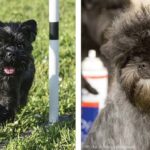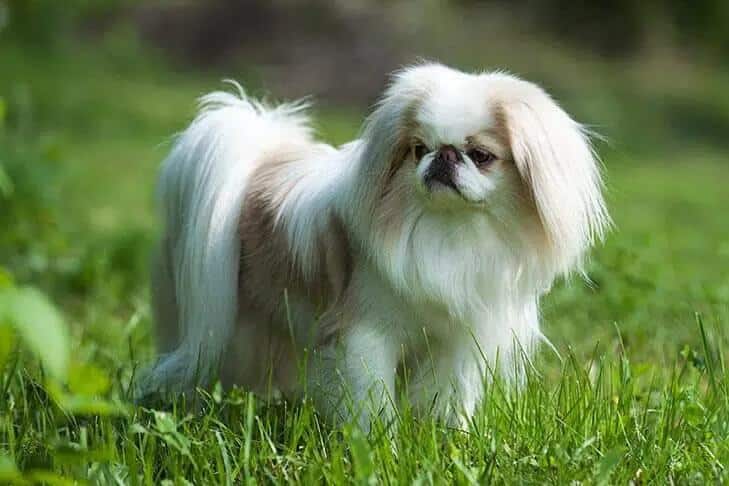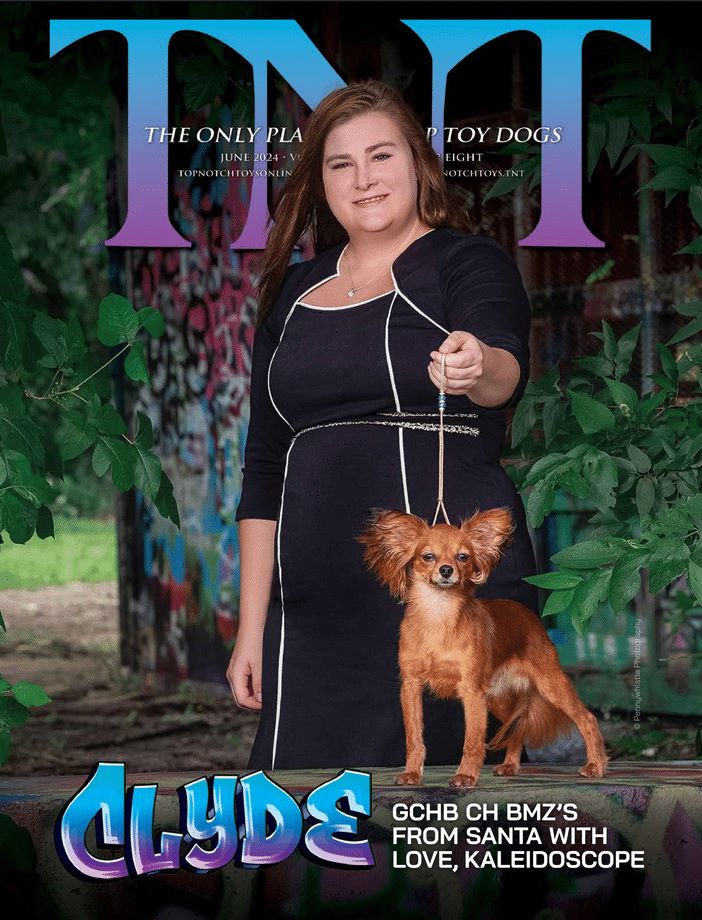The purebred Japanese Chin is an ancient breed brought forth through generations for one thing. This breed’s only job is to be adorned as a beautiful creature of living art. If you look at antiquities, you may find a representative of this breed which looks very similar to the dogs in the show ring today. Though it is thought that the breed originated in China, it crossed over to Japan through the Silk Trade routes where the country made it its own. As with all things Japanese, this breed was a sight to behold and treasure, as it was owned and cherished mostly by the nobility and given as living gifts to ambassadors in high society treaties and traveling dignitaries. The purebred Japanese Chin was one of the earliest breeds to be registered with the AKC, being registered in 1888, the same year that August Belmont Jr. became the club’s president. The first Japanese Chin, still known as the Japanese Spaniel, to be registered with the AKC, was a male of unknown parentage and breeder named Jap.
The purebred Japanese Chin is an “extreme” breed in their breed standard. Many things that are wanted in this breed, to make its characteristics unique, are not found in many other breeds. They are small and solidly built yet refined. They have an inquisitive, bright, alert and intelligent expression. This breed looks into your eyes and can read your soul.
The head and face of the purebred Japanese Chin are perhaps the breed’s most defining features. Additionally, the Japanese Chin would never be described as wrinkly or jowly, unlike a Pug. The eyes should be large, round, set far apart, dark as possible with a small amount of white in the inside corners of the orbit, giving it the characteristic “startled” or “astonished” look. The skull is large, broad and slightly rounded between the ears but not domed. Their ears as small and v-shaped also set wide apart slightly set below the crown of the skull and well feathered. Their profile is unique in that the forehead and muzzle touch the same vertical plane of a right angle whose horizontal plane is the top of the skull. The nose is set on the same level between the eyes and slightly upturned. Their jaw is wide and teeth are slightly undershot. The front feet are hare-shaped and allowed the slight outward setting with long feathering about the toes. They have square body with a moderate length of neck, they are moderately wide in the chest and have round ribs and their tail is set high and carried arched over their back with a flowing plume of hair. They have a “tight fitting,” long, elegant, single, silky coat, not falling equally to the ground, but giving the little dog a unique silhouette. In males, they develop longer coat standing slightly off the body around the neck and chest resembling a miniature mane. The head, face and legs have considerably shorter hair. They resemble a tiny ancient Far East Dragon with their lively movement and antics. This is a very intelligent, sensitive and loving little dog with its only purpose to serve man as a companion. They are extremely loyal and responsive to those they know, but reserved with strangers or in new surroundings.
The purebred Japanese Chin comes in several colors; black and white, sable and white, red or lemon and white and black and white with tan points. Our breed is specific in that it does not allow colors other than these, but there can be ranges of yellow lemon to “Irish Setter” red. Sable has black-tipped hairs which when first born look black, but as the hair and puppy grows, the tips can stay black or completely grow out to the sable red color. A sable and white Chin has black nose leather and pigment but a red/lemon and white has a self-colored nose ranging from liver to flesh colored pigment. The black and white with tan points should only have the tan on the pips above the eyes, cheeks and around the anus if there is black markings there.
Black, tan and white is a pattern and the afore mentioned is required to be correct markings. The “tan” points can also range in color from rust to fawn with the former being more desirable. Color patterns vary on the body, but the head should be marked or patterned as symmetrical as possible.
Purebred Japanese Chin range in size from tiny to rather middle size but the preferred range of size is around eight to 11 inches at the withers and around seven to 10 pounds.
The average judge may miss these special characteristics in this “one-of-a-kind breed” because they would not see a plethora of Chin in a lifetime unless they would be going to Specialties or are around a great number of Chin as these dogs are not seen much in the show ring. Those judges with a keen eye and knowledge would find, appreciate and reward a well bred Japanese Chin.
Breeders, too, can miss the attributes of what makes a Japanese Chin a Japanese Chin due to over emotional feelings for their individual little Chin. They do have a way to “get under your skin”; emotional decisions can interfere with a breeding program. In order to have a good solid breeding program a breeder must make the hard decisions and realize there are individuals that should not be bred.
Breeders call this breed a “heartbreak” breed because newborns fail to thrive, bitches are not good mothers, vigilance is not met or just breeding inferior unhealthy dogs can result in loss and tragedy. Japanese Chin breeders have a responsibility to breed healthy and tested Chin that continues to represent these breed characteristics. If bred with care and commitment, it is possible to have healthy dogs that carry these unique features that make it a Japanese Chin. This breed is able to live a long life without breathing problems, heart disease and other maladies that have been known to plague the breed. Heart problems such as congestive heart failure and mitral valve prolapse should be monitored with breeding dogs. If your vet hears a murmur or even questionable sounds, an echocardiogram is a must. The result should determine responsible decisions. Dental hygiene being most difficult in this breed because of the tiny teeth you cannot usually brush plus the Chin’s finicky appetite if you try to add anything to their diet. Putting them under anesthesia for a yearly dental is very detrimental for this breed because of their problems with intubation and the anesthesia. Collapsing trachea is also a grave concern for Chin and can lead to breathing difficulties later in life. Being a blunt-faced breed it is imperative that they do not pant excessively, as this could cause irreparable damage to the esophagus or soft palate. As with all small dogs, patellar issues and eye disease are also found in the purebred Japanese Chin. Even though Chin do not have a “working” job, we still have an obligation to give them a long, healthy life free of crippling diseases and arthritis. The average life span for a Chin is 10 to 12 years.
The purebred Japanese Chin is the ultimate companion dog in almost all aspects and the breed’s temperament is no different. This breed is supposed to be the treasured and delightful companion of royalty and it certainly acts like it knows it. They can be spoiled easily and manipulate you into doing so. Japanese Chins are incredibly affectionate with their owners, often fawningly so. This breed is definitely a licker. The Japanese Chin is not necessarily a one-person dog and is more than capable of meeting new friends whom it will eventually greet just as affectionately as its master. However, this breed does not make friends instantly and many are suspicious of strangers. Socialization is very important for the Japanese Chin, because if they are not exposed to new situations from a very young age they often become very timid and possibly fearful.
Purebred Japanese Chins are very gentle dogs and are recommended as one of the most ideal breeds for senior citizens. However, Japanese Chins generally do not get along well with young children. This is an incredibly gentle and fragile dog, which is likely to be injured by the play of even the best-meaning children. Additionally, this breed does not enjoy any sort of roughhousing and may respond very negatively to a child’s actions. This breed craves human companionship and is very likely to develop severe separation anxiety. If you have to leave a dog at home for long periods of time each day, the Japanese Chin may not be the ideal breed for you. The Chin’s look on life is rather complex but actually simple. They are silly, toddler child-like and yet wise beyond their little doggy years. If you are lucky to live with more than one you will see this daily (they do seem to enjoy the company of other Japanese Chin.) Routine is not in their vocabulary. They become bored with the mundane and will find ways of making life more enjoyable to them, not necessarily for you. They can be finicky and picky eaters and the next moment will gobble anything they see. They are much like cats. They love to be in high places and can be found more often than not on the back of your chair, couch or head. I have a tiny 1.3 ounce Chin that thinks she is a parrot and her favorite place is my shoulder, either sitting on the couch or driving in the car.
Even though they have lively personalities it is definitely not a high-energy breed. They do require regular daily walks or running around a safely enclosed area. However, they do require less exercise than other breeds. Purebred Japanese Chin have competed in agility and obedience and other performance events. Japanese Chin are generally easy to train or train you. As with many toy breeds, the Chin can easily develop a Napoleon Complex or Small Dog Syndrome if not disciplined and coddled. Owners not dealing with bad behavior appropriately usually cause this. The Japanese Chin is not a barky, yappy dog and is relaxed and less dominant than most toy breeds.
The purebred Japanese Chin is a treasure to cherish yet, there are few and far between that love the show dog life. They only love to be with their people and it is only through this love that they will do what you wish.
The purebred Japanese Chin is a “wash and wear” kind of dog and proper coat means less tangles and mats. This is not a hypoallergenic breed and does shed. They do not necessarily require professional grooming but must have a thorough brushing at least every other day. This breed only needs to be bathed when necessary. Their ears must be cleaned regularly as well as the anal area kept clean of debris from “cling-ons.” Being a brachycephalic breed their head goes through different growth stages and eye tearing may be present in young puppies. Care should be taken to clean this stained area and keep it dry. Care should also be taken with extreme heat with this breed. Japanese Chin can overheat quickly in warm weather making it difficult for them to breathe.
As a living piece of art and a toy dog, the purebred Japanese Chin must be cherished and cared for in the most careful manner. To be enjoyed, the Chin needs to share a wonderful life with its person, being treated as the rare and sensitive being it is. For all this care and companionship, one receives in return so much love, devotion and fun. The Japanese Chin is the only dog I know who has direct eye contact with its human from the time it is a puppy, thus reading your thoughts. Because of this eye contact and ability to search your face, they share your every emotion and give in return the ultimate in comfort, companionship and love.
Purebred Japanese Chin
Photo courtesy by the American Kennel Club.
From the July 2018 Issue of ShowSight.









